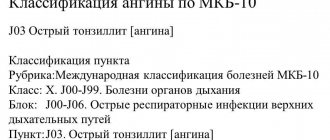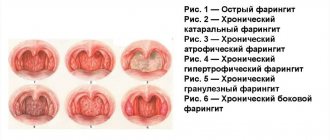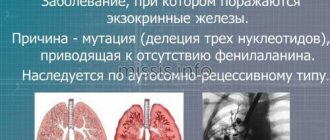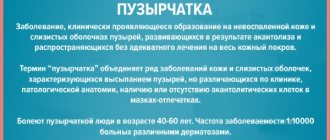What is purulent sore throat?
Purulent tonsillitis in a child is a type of acute tonsillitis. It occurs as a complication of the lacunar or follicular form of the pathological condition. Children aged 4 to 8 years are susceptible to the disease.
Attention! The causative agents of infection are mainly staphylococci and streptococci.
Purulent sore throat by origin:
- primary – develop as an independent inflammatory reaction;
- secondary - lesions arise against the background of infection or pathology of the hematopoietic apparatus;
- specific - development is associated with specific infectious diseases, for example, fungal tonsillitis.
What are the symptoms?
Sore throat does not occur from hypothermia. Its causative agents are harmful bacteria, fungi and viruses.
If there is caries or stomatitis in the mouth, then they can also provoke further development of the disease, resulting in a purulent sore throat.
Injuries to the tonsils and smoking will lead to the same effect. There are two types of purulent tonsillitis:
- Lacunarnaya. With this form, only the tonsils in the area of the lacunae are affected, they swell and expand. The appearance of a yellow-white coating is characteristic, which is easily removed without leaving any traces;
- Follicular. With this form, deep damage to the lymph nodes occurs. They become swollen and bright red. In this case, purulent plaque is almost impossible to remove. When purulent foci merge, an abscess forms.
Diagnosis of purulent sore throat
Purulent tonsillitis in a child is diagnosed by otorhinolaryngologists on the basis of complaints, medical history, objective examination and data from laboratory and instrumental research methods.
When collecting anamnesis and complaints, he finds out when the first symptoms appeared and what they are associated with. The nature and severity of symptoms. Thus, ARVI is excluded and the origin of the sore throat is established.
An objective examination consists of pharyngoscopy - examination of the oropharynx. The child has pronounced redness and an increase in the size of the tonsils, as well as hyperemia in the area of the palatine arches and soft palate. Lymph nodes are enlarged and painful on palpation. Focal or total purulent lesion of the oropharynx.
A smear from the affected area is required to determine the pathogen in order to prescribe adequate therapy in the future.
Taking a general blood and urine test to determine the level of lymphocytes, erythrocyte sedimentation rate and specific markers of inflammation.
Attention! If the pathogen cannot be isolated from the smear, the child is prescribed a polymerase chain reaction.
Treatment of viral and bacterial sore throat
Since tonsillitis is acute, it is necessary to begin its therapy when initial symptoms appear. This reduces the duration of treatment, the severity of the disease and prevents the occurrence of consequences. In acute forms of pathology, it is necessary to adhere to bed rest. Many people ask how long a sore throat lasts in adults. Adults, as well as children, should stay in bed for the first few days of illness until their temperature returns to normal.
Then the patient is allowed to lead a more active lifestyle, but he is required to continue the prescribed therapeutic regimen and follow medical instructions for another 6-8 days. During this period of illness you should not leave your home, therefore it is necessary to issue a sick leave certificate. In the case of acute tonsillitis, the patient is relieved of work duties for a week (this is exactly how long the standard course of using antimicrobial agents lasts). Antibacterial drugs are an indispensable component in the treatment of sore throat. It should be understood that the use of antibiotics is justified only in the situation of diagnosing streptococcal infection in the tonsils.
It is possible to accurately identify the causative agent of the disease through clinical blood diagnostics or bacterial culture of a smear from the oral cavity. When the provoking factor of the disease is a virus, the basis of therapy will be local antiseptic drugs:
- Bioparox.
- Faringosept.
- Cameton.
- Inhalipt.
Rinsing the mouth and throat with tinctures of medicinal herbs (chamomile, calendula, eucalyptus, etc.) or antiseptics (Furacilin, water with propolis tincture, etc.).
The duration of treatment for tonsillitis in adults, which is not complicated by infection, is a week.
What does a purulent sore throat look like?
There are 4 forms of sore throat:
Phlegmonous. The tissue of the tonsils is affected. One-sided defeat. Follicular. The lesion is located in the follicles of the tonsils. The latter have small abscesses. Fibrinous. Pus is spread over the entire surface of the soft palate. Often loss of consciousness, objectively – shortness of breath. Lacunarnaya. Pus enters the lacunae due to flow from the follicles. The lesion is not located in a specific area, but looks like a plaque.
Varieties and atypical forms
Sore throats can be classified according to a number of features, but most often the type of tonsillitis is determined by pharyngoscopic signs.
Classic types of sore throat (sometimes called vulgar):
- catarrhal,
- streptococcal or GABHS,
- lacunar,
- follicular,
- phlegmonous.
Vulgar tonsillitis is characterized by the presence of the following symptoms:
- sharp symptoms of intoxication of the body;
- pathology of both tonsils;
- the illness lasts no more than a week;
- an infection (viral or bacterial) caused the disease.
There are also atypical forms of sore throat:
- herpetic;
- accompanying scarlet fever;
- tonsillitis due to diphtheria;
- sore throat due to syphilis;
- mononucleosis (caused by Epstein-Barr virus);
- tonsillitis with agranulocytosis;
- hemorrhagic manifestations of the tonsils in cancer;
- Simanovsky-Plaut-Vincent tonsillitis;
- candidiasis.
It is also customary to distinguish between the forms of tonsillitis depending on the location of the disease, i.e. depending on which part of the lymphoid ring was infected.
Classification of types of sore throat:
- laryngeal or acute epiglottis (infection of the lymphatic tissue of the epiglottis);
- lingual (inflammation of the lingual tonsil);
- ulcerative-necrotic;
- adenoiditis or infection of the pharyngeal tonsil.
But most often purulent tonsillitis has a mixed nature of occurrence. As a rule, the main diagnosis is first established, and then, after diagnostic studies, information is added regarding the type of pathogen and the characteristics of pathogenesis.
Symptoms and signs
In a pathological condition, the following signs are revealed:
- pain in the abdomen, head and throat;
- weakness;
- formation of abscesses;
- convulsions;
- inability to swallow food;
- tachycardia;
- cold clammy sweat;
- enlargement of the submandibular lymph nodes;
- bowel dysfunction;
- nausea and vomiting;
- increase in body temperature up to 40 degrees.
Attention ! On the first day of the onset of the disease, only enlarged tonsils will be detected from the symptoms.
The temperature rises for 2-3 days, the baby becomes drowsy and does not show activity. Due to the appearance of a sore throat, a respiratory disorder is diagnosed.
Swelling of the tonsils causes increased pressure on the Eustachian tubes. This leads to ear congestion and noise in them. Often the inflammatory process spreads to this area.
Characteristics of an advanced form of sore throat
As you can see, the consequences of purulent tonsillitis can be quite serious. And this is only in the early stages of its development. In the future, it becomes no less, but, on the contrary, more dangerous, causing irreversible consequences for the human body. Based on this, it follows that waiting until the immune system overcomes the infection is simply impractical, since the disease will not go away on its own, without appropriate treatment. In turn, late periods, which occur 2-4 weeks into the course of the disease, may be accompanied by the following complications:
- rheumatic fever;
- glomerulonephritis;
- inflammation of the tissue around the tonsils.
The above conditions can affect the further functioning of internal organs, so it is better to prevent their occurrence. Thus, rheumatic fever involves damage to connective tissue, which affects the cardiovascular system. As a result, its functioning undergoes changes, affecting the functioning of almost all organs supplied with blood, and the heart in particular.
Glomerulonephritis is a non-infectious inflammation of the kidneys, leading to a wide variety of disorders, ranging from problems with urination to disruption of their functioning. The most negative outcome is kidney failure, which can last a lifetime.
One of the most dangerous complications of this disease is inflammation of the tissue tissue localized around the tonsils. Penetration and development of infection in them inevitably leads to the appearance of ulcers of both abscessive and phlegmonous nature. The appearance of such a condition is indicated by the occurrence of acute pain localized on one side of the throat, as well as the appearance of difficulties when moving the head. In this case, the occurrence of an inflammatory process in the tissue tissue of the tonsils occurs rapidly within 1-2 days, accompanied by an increase in the general symptoms of tonsillitis, which requires prompt and complete hospitalization. As a rule, getting rid of problems of this kind is carried out surgically using a scalpel and a drainage system that pumps out pus from the affected cavities.
Causes of the disease
In addition to the causative agents of the disease - streptococci and staphylococci, the pathological condition is provoked by viruses, fungi and mycoplasma.
Attention! If the child’s immune system is not weakened, pathogenic microflora is not dangerous.
Provoking factors are weakened immunity, recent viral infections, often hypothermia, constant exposure of the child to a damp climate, unbalanced nutrition, overwork, both physical and emotional.
In infants, a common cause of pathology is hypothermia. In a one-year-old baby, the disease occurs against the background of an infection of viral etiology or adenoids.
The disease is transmitted through household or airborne transmission. Less commonly, the infection spreads from other lesions located in the oropharynx.
The repeated occurrence of purulent tonsillitis leads to the transition of inflammation into a chronic form.
How long is the incubation period?
The incubation period in children varies in terms of timing. It depends on the individual characteristics of the body, age and the capabilities of immune mechanisms. The period lasts from 12 hours to 3 days after the infection enters the body.
What is absolutely not recommended to do
If there is an admixture of blood in the sputum, you should under no circumstances use decoctions of medicinal herbs - the banal procedure of gargling can lead to increased bleeding.
If the patient finds wounds on the mucous membrane of the tonsils, then he needs to stop the plaque removal procedure and often use honey, slowly dissolving it.
Under no circumstances should you use any hemostatic drugs without a doctor’s prescription! Firstly, in most cases of this situation they are absolutely useless, and secondly, you must first determine the cause of the appearance of blood in sore throat.
Sputum mixed with blood during a sore throat should not lead to panic. In most cases, this sign does not signal any complex pathology, since it is generally quite rare. But you will have to seek qualified medical help - you need to make an accurate diagnosis and undergo competent treatment.
How to treat purulent tonsillitis in children in 2020?
Treatment of purulent tonsillitis in children is carried out on an outpatient basis or in a hospital. Hospitalization is required in the following cases:
- acute inflammation, high likelihood of complications;
- age less than three years;
- The child's immune system is not functioning properly.
In other cases, treatment of purulent sore throat in children is carried out at home under the supervision of a doctor.
General recommendations
The child is required to observe a work and rest schedule. Bed rest is prescribed. The baby should sleep all day and night. It is necessary to provide adequate nutrition, rich in vitamins and minerals. Since it is difficult for the patient to swallow, food should be crushed, and puree soup is recommended. Parents provide complete peace. In the room where the child is, wash the floors at least 2 times a day. Ventilate the room before removing the baby from it.
Breastfed babies continue to be fed mother's milk. Drinks for all children are recommended to be warm, but not hot. Dried fruit compote or raspberry tea. These drinks relieve inflammation and strengthen the immune system.
How does a humidifier affect healing?
The use of an air humidifier ensures the creation of an optimal microclimate in the room for the child and recovery. In addition to creating the required conditions, the equipment cleans the room of dust particles. This allows for no ventilation.
An air humidifier normalizes the functioning of the baby’s affected pulmonary system. This is due to the fact that moist air prevents sputum from stagnating in the lungs. The disease progresses faster and easier, and the risk of complications is minimized.
Antibacterial therapy
For purulent sore throat, a specialist must prescribe penicillin antibiotics, for example, Amoxicillin. If the patient has frequent relapses of the condition or an allergic reaction to this series of antibacterial agents, a group of macrolides is prescribed, for example, Sumamed.
more about how to use antibiotics during a sore throat in the article.
If penicillin and macrolides are ineffective, cephalosporins are prescribed, for example, Ceftriaxone. Injections are administered only in a hospital setting and with constant dynamic monitoring of the patient. This series is also used when there is a high risk of complications and the condition is severe for the child.
Attention! Antibiotics for purulent sore throat in children are used for 7-10 days. If completed earlier, the pathogens will develop tolerance to this group of medicinal substances, that is, they will not cure the next time.
Local treatment
Local treatment for purulent sore throat in children consists of using:
- absorbable tablets with antimicrobial, antiseptic and antibacterial effects, for example, strepsils;
- use of antibacterial aerosols, for example, Tantum;
- gargling with antiseptics, for example, Chlorhexidine.
Children under one year old do not know how to dissolve tablets and gargle, so only aerosols are prescribed for local therapy.
What antibiotics should I use and how much should I give them?
Therapy, as mentioned above, is mainly carried out using antibiotics that destroy pathogenic microflora. The penicillin series is prescribed first, since the drugs are the safest for the child. They do not cause intolerance and are in no way associated with food intake. The doctor prescribes the dose based on body weight. In this case, everything is individual for a particular child.
If the attending physician cannot prescribe penicillins, for example, Augmetin, the following are used:
- macrolides – Azitrox;
- cephalosporins, for example, Suprax, as the drug of choice;
- in some cases, patients are prescribed sulfonamides, for example, Biseptol. Of all the medicinal substances, this series is the most gentle. However, its use is limited because bacteria can develop tolerance to this type. In this regard, if after 2 days of treatment no positive dynamics were detected, the treating specialist adjusts the therapy;
- local antibiotics affecting the tonsils, for example, Bioparox.
Together with antibacterial therapy, drugs to prevent dysbacteriosis, for example, Linex, should be given. To maintain the functioning of the immune system - vitamin complexes.
Symptomatic treatment
If a child has a high temperature, but the extremities are cold, it means that vasospasm is developing. To stop it, give half a tablet of Drotaverine.
During antibacterial therapy, a fungal infection may develop. To avoid this, use antifungal drugs, for example, Ketoconazole.
In order to relieve signs of intoxication - antiallergic drugs (Suprastin).
Probiotics and prebiotics - Bifi-Form - will help normalize the intestinal microflora.
How to gargle a child's throat?
Gargling is an effective procedure because the oropharynx is disinfected, which reduces the inflammatory reaction and reduces the risk of spreading the process. Also, rinsing allows you to relieve pain and wash away pus from the surface of the tonsils.
It is recommended to carry out the procedure frequently, every 4 hours. The head should be thrown back, the tongue should stick out as much as possible so that the solution reaches the far parts of the pharynx. The process must take at least half a minute, and the solution must be warm.
The specialist prescribes solutions with medications - Chlorhexidine and furatsilin solution. Take 10 ml of the substance and gargle 2-3 times a day. It is also acceptable to use solutions based on herbs or soda. Soda solution - take 1 tablespoon and dissolve in hot water. The procedure is carried out at least 5 times a day.
The salt version is prepared in a similar way. If you need to use herbs, take 1 tablespoon of chamomile and pour a glass of boiling water, let it cool to room temperature and only after that the child.
How to lower the temperature?
With purulent sore throat, the child’s body temperature can reach 40 degrees Celsius. Its reduction is achieved by taking antipyretic drugs that include paracetamol, for example, Panadol.
Attention! The temperature can be brought down only when it reaches 37.9 degrees; if it is lower, the body must fight on its own. Otherwise, the baby's immune system is suppressed.
Physiotherapeutic procedures
Physiotherapeutic procedures for angina are prescribed to all children at the onset of the disease. If the lymph nodes are significantly enlarged and painful on palpation, UHF is used. Pine needle baths, oxygen treatments and microwave therapy have a good therapeutic effect.
Features of therapy for hemoptysis
Here doctors take individual therapeutic measures. And such treatment will pursue two goals:
- prevent blood clots from entering the lungs, as this can lead to asphyxia;
- stop the bleeding.
If the patient is already undergoing treatment for a sore throat with antibacterial drugs, they will have to be replaced - hemoptysis is considered one of the side effects of long-term use of antibiotics.
If hemoptysis intensifies and changing antibacterial drugs does not bring the expected result, the doctor may prescribe postural drainage. In any case, hemoptysis due to a sore throat is a condition in which the patient must observe strict bed rest.
If the bleeding is massive, then after examination the doctor may prescribe the patient a procedure for cauterizing the bleeding areas of the respiratory tract. This helps to quickly stop bleeding, but keep in mind that the procedure is not a panacea. The fact is that even after cauterization, against the background of a strong cough, the lesions can begin to bleed again.
Very often, when diagnosing hemoptysis due to a sore throat, doctors perform bronchoscopy - this procedure allows not only to accurately determine the source of bleeding, but also to carry out therapeutic manipulations.
Please note: as part of the treatment of hemoptysis due to tonsillitis, the administration of frozen blood plasma, platelets or blood-clotting factors is prescribed.
Traditional methods
Is it possible to treat purulent sore throat in children at home?
It is permissible to use traditional medicine only after consultation with your doctor.
Carefully! A child may have an allergic reaction to some components, so you need to start with small dosages. In addition, such drugs reduce the effectiveness of antibacterial therapy prescribed by a doctor.
Recipes:
Take one fresh medium-sized beet and grate it on a fine grater. Next, pour a glass of boiling water. The resulting mixture is infused overnight, and in the morning the baby is given to gargle. Since the solution must be used at least 3 times a day, it is advisable to prepare several servings at once.
Take an onion and remove the dry yellow skin from it. Place in a saucepan and boil for 5 minutes. Then remove the container from the heat and leave in a dark place for at least 3 hours. Gargle every 3 hours.
Take aloe juice and honey. Mix in a 1:1 ratio and gently lubricate the outside of the throat. After this, the affected area is wrapped in a woolen scarf for 3 hours. On the first day of development of the pathological process, the procedure is repeated at least 4 times a day.
Rehabilitation activities
The doctor prescribes a course of rehabilitation for those children who have a complication of the underlying disease, as well as for those who have frequent relapses of purulent processes. The child must attend long-term therapeutic and preventive physical education. Special breathing exercises with deep breathing are also recommended.
How many days does it take to treat a sore throat?
The most common cold that affects the throat and causes significant discomfort is sore throat. But if you yourself or your child are sick, for one reason or another you will be concerned about the question: how long does it take to treat a sore throat? This disease is an inflammation of the tonsils, accompanied by a white purulent coating. The development of this pathology in medicine is called tonsillitis. The answers to the questions described in this article cannot replace the advice of an experienced doctor, but are given only to encourage you to make the right decision in the treatment of this rather serious disease.
The duration of the disease manifests itself differently in everyone, and how many days to treat a sore throat depends on many factors. On average, the patient is cured within 5-7 days. The inflammatory process can also be localized in other accumulations of lymphoid tissue of the pharynx:
- in language;
- in the pharyngeal region on the tonsils;
- on the side bolsters (retronasal tonsillitis);
- in the area of the larynx.
This course of sore throat can last for more than 7 days.
How long does it take to treat sore throat in adults?
In adults, the course of treatment can last about a week, it all depends on the type of sore throat, which happens:
If the disease does not go away within 7 days, it is necessary to undergo additional examination. Adults are most susceptible to the disease at the age of 35-40 years.
Possible complications
Purulent tonsillitis can provoke early and late complications. Early manifestations are associated with the spread of the purulent process to organs lying next to the affected area. These include otitis media and mediastinitis. One of the rare but dangerous processes is severe swelling of the tonsils. This can lead to suffocation, especially at night.
Late complications develop several weeks after the baby is cured. These include renal failure, sepsis, rheumatic fever and others.
If relapses are frequent, acute inflammation becomes chronic. Due to the fact that the source of inflammation is constantly located in the tonsils, pathogens constantly move through the bloodstream throughout the body, causing an inflammatory reaction in other organs.
In the chronic form of the disease, as well as in the absence of positive dynamics from traditional treatment, surgical intervention to remove the tonsils is prescribed. Contraindications for surgical treatment are diabetes mellitus, heart defects of the 2nd and 3rd stages and hemophilia.
As soon as parents notice symptoms of purulent tonsillitis in a child, they should immediately contact an otolaryngologist. Only he can prescribe adequate treatment that will bring positive dynamics and minimize the risk of complications. After recovery, it is recommended to retake urine and blood tests, as well as undergo a consultation with a nephrologist, immunologist and rheumatologist.
Diagnosis and correctly prescribed treatment can achieve a favorable outcome of the disease. Frequent relapses and complications worsen the prognosis. Therefore, measures should be taken to stop the development of the inflammatory process.
Acute tonsillitis at the initial stage
The consequences of purulent sore throat in the early stages can be devastating, so it must be treated from the first days, before the inflammation begins to spread further.
However, due to the acute nature of the disease, complications can develop within several days. Based on this, it follows that the slightest delay in the case of purulent tonsillitis can be fatal and bring a huge number of problems. Pharyngeal abscess is one of the most complex and dangerous cases that can occur at the primary stage of the disease. During its development, huge abscesses form, filling almost the entire free cavity in the throat. Moreover, each of them carries a double danger, since it increases the risk of damage to neighboring areas and penetration of infection into the chest cavity or brain, and also contributes to the breakdown of all mucous membranes with which the pus comes into contact.
Infectious-toxic shock occurs as a result of poisoning of the body with waste products of bacteria and partial disintegration of the body’s own tissues. This symptom is associated with abundant pus formation, which greatly affects the condition of the body.
The formation of meningitis is possible when the bacterial environment penetrates directly into the brain area. As a rule, this becomes possible thanks to the fascial spaces of the neck, through which the infection rises up and penetrates into the skull.
Sepsis is nothing more than a blood infection that occurs due to the penetration of bacteria directly into the blood, which circulates throughout the body and can cause damage to absolutely all organs, which poses a particular danger to human health.
Preventive actions
There is no 100% effective prophylactic remedy, however, there are a number of recommendations to reduce the likelihood of developing purulent tonsillitis.
Attention! Strengthen your immune system through hardening procedures and including foods rich in vitamins and minerals in your diet.
The child must observe the rules of personal hygiene, since most infectious agents enter the body through household means. Also, to strengthen the immune system, follow a work and rest schedule.
It is necessary to exclude hypothermia of the body and promptly treat diseases of the oral cavity and nasopharynx.
Purulent tonsillitis is a common pathological condition that requires mandatory treatment. The disease is dangerous due to early and late complications.
Nutrition
You need to include light foods in your diet that are rich in vitamins. Since there will be pain in the throat, it is likely that there will be a problem with swallowing food. Dishes should be eaten only in semi-liquid, pureed form and in a warm state. Hot and cold are not recommended in this case. It is necessary to exclude from the diet foods that will irritate the mucous membrane, these could be:
- Seasonings,
- Spices,
- Beverages,
- Alcohol,
- Rough food.
The main emphasis in nutrition should be on:
- Cottage cheese,
- Pudding,
- Eggs,
- Vegetable purees,
- Boiled meat (shredded),
- Yogurt,
- Porridges made from rice, oatmeal and semolina.
You can eat broths based on meat, fish, chicken, drink warm juices, jelly, compotes, mousses.
But the list of prohibited products will include canned food, baked goods, pickles, sweets, cakes and pastries, alcoholic cocktails, soda, smoked and fried foods. You need to eat 5 times a day, but only in small portions.
With antibiotics
As a rule, normalization of the patient’s condition occurs within 1-2 days after starting antibiotics. This is due to the fact that the effective drug destroys the infection in the tonsils in 12-20 hours, after which the inflammation subsides and the temperature begins to decrease.
Thus, when using antibiotics, purulent sore throat goes away in 3-4 days, that is, its duration is shorter than when refusing antibiotic therapy.
However, standard antibiotic treatment involves the use of drugs for at least 10 days to reliably prevent complications and completely suppress the causative agent of sore throat in the body. A seeming contradiction is connected with this: if without treatment a purulent sore throat goes away in 8 days, then the treatment itself has to be carried out for two weeks.
In fact, there is no contradiction here: antibiotics are used not only and not so much to normalize the patient’s condition, but to protect him from complications. This is a longer process than simply suppressing the infection.
Prevention
To prevent a sore throat of a purulent or other severe type, it is recommended to take preventive measures:
- avoid hypothermia;
- do not abuse cold drinks, ice cream, especially in the heat;
- strengthen the immune system with vitamins and hardening;
- promptly treat caries and other oral diseases;
- Regularly rinse your mouth and throat with boiled water or a weak saline solution.
All patients diagnosed with purulent tonsillitis should understand how serious this disease is. In case of pathology, adequate therapy is necessary, since the disease, with improper treatment or its complete absence, can easily become chronic. Follow all the doctor’s recommendations and you will recover quickly. Good health and don't get sick!
Drug treatment
Effective medications for the treatment of sore throat
If you have symptoms of a sore throat, you should consult a specialist. Taking into account the type and severity of the disease, the doctor will prescribe the correct treatment, which includes the use of the following therapeutic methods.
- For sore throat, gargling is recommended. For these purposes, various means are used, both folk and medicinal. There are a large number of antiseptic solutions: Rivanol, Furacillin, Iodinol, Eludril, Potassium Permanganate, Miramistin.
- Lozenges or lozenges help reduce sore throat and relieve inflammation. The following drugs are popular: Strepsils, Stopangin, Falimint, Hexoral Tabs, Grammidin, Faringosept.
- Various treatments and aerosols have a good effect in treatment. These drugs include: Hexoral, Cameton, Lugol spray, Ingalipt, Tantum Verde, Eludril, Hexasprey.
- In case of illness, it is recommended to use vitamin-mineral complexes, including ascorbic acid and B vitamins (Multitabs, Centrum, Pikovit).
- Used in the treatment of sore throats and immunomodulators. Kipferon and Viferon are effective in this regard.
- Sometimes, to relieve swelling in the throat as a result of allergens, antihistamines, for example, Suprastin, Cetrin, Claritin, Loratadine, can be prescribed.
More information about angina can be found in the video:
Inflamed tonsil on one side: causes and treatment
In addition, for a quick recovery, it is advisable to adhere to a proper balanced diet, including foods that will least irritate the throat. Drinking plenty of fluids is also important for treatment.
Incubation period
The incubation period of purulent tonsillitis is the time from the entry of the pathogen to the appearance of the first signs of the disease. The duration of the period varies from several hours to 2-4 months.
Is purulent sore throat contagious?
Of course, yes, if you do not adhere to the rules of hygiene and do not wear a protective bandage when in contact with a sick person. The risk of getting a sore throat increases if a person is hypothermic, if he has a low immune system, and also if he has bad habits: smoking and alcohol abuse.
Temperature after a sore throat
Sometimes, after eliminating the symptoms of a sore throat and visible recovery, the body temperature rises to 37 degrees or higher and persists. The reasons for an increase in the level to low-grade fever may be the following:
- untreated sore throat;
- weakened immune system;
- the appearance of complications;
- addition of a secondary infection;
- a consequence of the action of medications;
- temperature tail.
Low-grade fever should not be a cause for serious concern if it lasts for the first 2 weeks after a sore throat. This is the so-called temperature tail, when a person’s thermoregulation tries to return to normal. If this period is delayed, then it is necessary to consult a doctor, since there is a risk of chronic tonsillitis.
If the cause of the temperature is the appearance of purulent plugs that trigger the inflammatory process, then the procedure of washing the tonsils will help get rid of them.
If the cause is complications after an illness, then you need to undergo another course of treatment.











